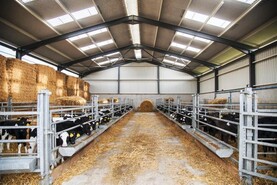The Food Vision beef and sheep report, as presented, suggests a way to deliver what has been inevitable since the publication of the KPMG report commissioned by the Irish Farmers Journal over a year ago.
KPMG stated that a reduction in emissions greater than 18% could not be achieved without a reduction in the cattle herd.
At the time, the final requirement of a 25% reduction wasn’t known and KPMG made their calculations on what would be required to achieve a 21% and 30% reduction.
A 21% reduction in emissions from agriculture would require a 6% cut to the beef herd plus a 5% cut to the dairy herd, while a 30% reduction would require a 22% cut in the beef herd along with an 18% cut in the dairy herd.
Achieving the 25% reduction in emissions that has been set for agriculture will mean a reduction somewhere in between these levels, as there is no other way of reaching that target.
Against this reality, it has been disingenuous to suggest that there will be no compulsory cuts on cattle numbers.
Instead, the evidence points to the Government taking a more subtle approach that will lead to the outcome of reduced cattle numbers, with the Food Vision beef and sheep report proposals the latest means to that end.
The direction of travel was already in place before this report. The CAP, which comes into effect next month, has already started the process as convergence and front loading makes it uneconomic for some of the most productive suckler farmers to maintain production.
The ambition to increase the area in organic farming by four times, with an “incentive” budget equal to all remaining suckler production, will also mean less livestock.
We are also starting to see the effects of higher fertiliser and energy costs on farmer decisions, with 52,000 (+16.4%) more cows culled this year compared to last year and record cow culls in the North where there were 13,400 more cows (+10.6%) killed than last year.
Back to the future
The suckler cow herd has already been shrinking over the past decade. In 2012, CSO census figures show that there were 1.149m suckler cows and 1.141m dairy cows.
With the abolition of milk quotas in 2015, dairy cows expanded both on dairy farms and by some suckler farmers switching. By 2021, suckler cow numbers had shrunk to 940,300 and dairy cow numbers had increased to 1.604m.
Interestingly, despite the growth in cattle numbers over the past decade, the total national cattle herd at 7.358m is 282,000 lower than it was in 1998!
Current policy may not compel farmers to cut cow numbers but they will be encouraged to do so. Of course the building of the suckler herd, which forms the foundation for our successful beef industry, was the result of a different policy at a different time.
Prior to the imposition of beef quotas in 1984, CSO figures for 1983 show 1.596m dairy cows compared with 471,700 suckler cows, less than one third.
The limit on milk production combined with support for sucklers led to a rebalancing of numbers in each category with a 50:50 split by 1998 and even a greater proportion of sucklers from around 2006-2012.
Inspiration from Poland
The beef factories are alert to the implications of current policy, by highlighting the job losses and loss of exports.
However, farmers have always showed they will respond to policy, and current policy means a reduced supply of quality suckler beef in future. This has been the platform on which we have promoted our industry, even though there has always been a significant input from dairy bred cattle.
Perhaps our factories will adapt and take the lead from their counterparts in Poland. There, factories have found a way to pay farmers on average in 2022, 21c/kg more for R3 young bulls than Irish farmers get for R3 steers!
Polish beef is drawn almost exclusively from dairy cows and like Ireland, Poland depends on export markets for close to 90% of its beef production.
With policy designed to encourage anything but production and no significant market premium, prospects are grim for suckler farming as we have known it in recent decades.
Farmers have to follow the money, and with an ever increasing amount of the carcase being minced, factories too will find a way.






 This is a subscriber-only article
This is a subscriber-only article









SHARING OPTIONS: